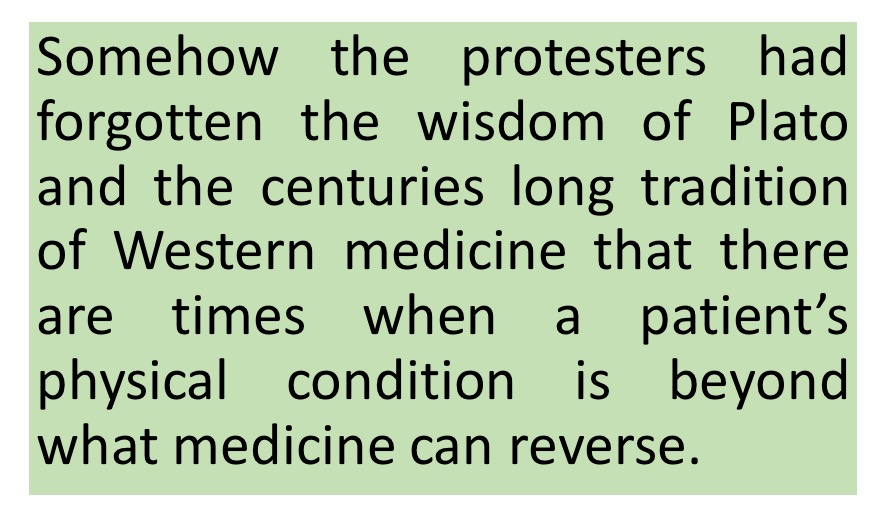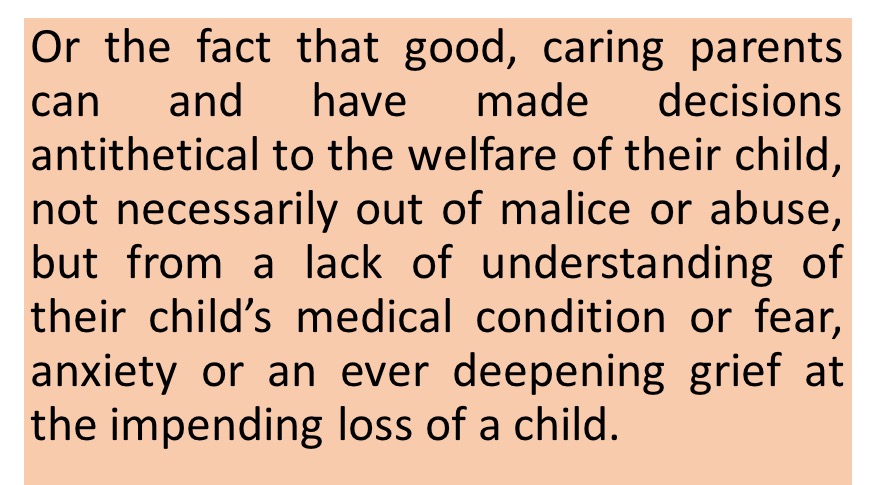by John J. Paris, SJ
The widely publicized conflicts between families and physicians over treatment decisions for profoundly compromised children in the recent Charlie Gard and Alfie Evans cases revive topics as old as the history of Western medicine on who should determine medical treatment and on what standard. The treatise in the Hippocratic Corpus entitled The Art defines medicine as having three roles: doing away with the suffering of the sick, lessening the violence of their diseases, and refusing to treat those who are overmastered by their diseases, realizing that in such cases medicine is powerless.” That theme is also found in Book III of Plato’s Republic. There Plato admonishes, “For those whose bodies are riddled with disease, [Asklepios] did not attempt to prescribe a regimen to make their life a prolonged misery.” A rebuttal of the critics’ position in the Gard and Evans cases that since private funds would be expended to cover the expenses of the treatments, there is no ethical issue concerning their use is found in Plato’s statement that “Medicine isn’t intended for such people…even if they are richer than Mitas.”
 Over the centuries the norms on who is to make the decisions and on what standard has been significantly revised and altered, particularly the once near absolute authority of the physician to make the decisions. That authority has evolved to include patient participation in decision making, the patient’s right to decline an unwanted medical intervention, and the present view in the United States that patient “autonomy” or self-determination gives the patient not only the right to decline an unwanted medical intervention, but the right to demand and be provided with whatever the patient or family wants.
Over the centuries the norms on who is to make the decisions and on what standard has been significantly revised and altered, particularly the once near absolute authority of the physician to make the decisions. That authority has evolved to include patient participation in decision making, the patient’s right to decline an unwanted medical intervention, and the present view in the United States that patient “autonomy” or self-determination gives the patient not only the right to decline an unwanted medical intervention, but the right to demand and be provided with whatever the patient or family wants.
The history of that transformation is explored in an essay entitled “The Metamorphosis of Bioethics” published in a 1993 issue of JAMA by Edmund Pellegrino. The furthest reaches of those changes are not the requests of the parents in the Charlie Gard case for access to a never-tested treatment for a rare genetic disorder for which there is no known treatment or the Evans case in which a child who had been hospitalized for 18 months without his treating physicians or specialists (consulted worldwide) being able to provide a cause for the child’s devastating brain deterioration. They are found, rather in such American cases as that of Baby K, an infant diagnosed in utero as having anencephaly, i.e., a well-known medical condition in which about the 26th day of conception the neural tube fails to close. Brain matter flows into the amniotic fluid. Consequently, the baby is born without a developed brain. In the Baby K case the mother demanded and obtained approval from a federal trial court and the 4th Circuit Court of Appeals for continuing respiratory support for her child. Baby K received aggressive medical treatment for over two years. She had a cardiac arrest and, despite a prolonged attempt at CPR, died.
An even more bizarre American case is that of Jahi McMath—in which a 13-year-old girl who, following difficult surgery, was diagnosed as brain dead. Although Jahi McMath was declared legally dead by a California court and a death certificate was issued, her mother maintained, “She is not dead. She [just] needs time to get better,” The mother insisted on continued medical treatment for her daughter because, as she put it, “In this country, a parent has the right to make decisions concerning the existence of their child, not a doctor who looks only at lines or reads the old black and white words in the law that says ‘brain dead.’” One can imagine the public health, as well as social policy implications, of a standard that allows individuals to determine who is and is not dead.
The British and American approaches for resolving disputes between the family and physician on whether to provide a medical intervention requested by the family are widely divergent. One might inquire, as did Mr. Justice Francis of the English High Court in the Gard case, “ He explained that “while a child’s parent have the power to give consent for their child to undergo treatment, in the United Kingdom overriding control is vested in the court exercising its independent and objective judgment in the child’s best interests.” This principal, he reminded the reader, has been enunciated over the years in many cases.
Justice James Holman of the High Court had provided the practical directives on how an English judge should proceed once such a dispute reaches the courts. Holman declared that the judge was not to decide on what he himself would do in such a situation, nor whether the respective decisions of the parents or those of the physician are ‘reasonable.’ The focus is exclusively on ‘the best interests of the patient.’ He also stressed that the views of the patents are not dispositive. In Holman’s forceful phrasing , ”Their own wishes, however, understandable in human terms, are wholly irrelevant to consideration of objective best interests of the child.” Mr. Justice Francis in his opinion in Gard also cited Lord Donaldson’s observation that while there is a strong presumption in favor of prolonging life “in the end there will be cases in which the answer must be that it is not in the interests of the child to subject it to treatment that will cause it increased suffering and produce no commensurate benefit.”
The United States lacks a unified decision making mechanism to resolve family-physician disputes. There guidance is the province of the legislatures and courts of 50 diverse states as well as the U.S. Congress and federal judiciary, each of which may set its own standards. In practice those standards range from the New Jersey Supreme Court’s decision to leave the final choice regarding the treatment of an incapacitated patient to the family to that of the New York Court of Appeals, that state’s court of final jurisdiction, that a life-sustaining medical intervention could not be authorized by anyone—physician, family, or court– absent ‘clear and convincing’ evidence from the patient when competent that such was his or her wish.
There is a greater emphasis in the United States on individual self-determination and a greater expectation on the freedom for individuals to spend their money as they please than in the UK. As a British neurologist stated in the Gard case, “In the United states, provided there is funding, they will try anything.”
 In addressing the issue of funding Mr. Justice Francis stated, “It is imperative that I make clear that this case is not about money and, if anyone were to suggest that Charlie would have nucleoside they but for the cost, they would be completely wrong.” He went on to note that Charlie’s treating physicians at London’s famed Great Ormond Street Hospital had considered trying nucleoside therapy, but abandoned that option when the Charlie’s seizures intensified. The further damage to Charlie’s brain, in their judgment, made the possibility of restoration of neurological function ‘futile.’
In addressing the issue of funding Mr. Justice Francis stated, “It is imperative that I make clear that this case is not about money and, if anyone were to suggest that Charlie would have nucleoside they but for the cost, they would be completely wrong.” He went on to note that Charlie’s treating physicians at London’s famed Great Ormond Street Hospital had considered trying nucleoside therapy, but abandoned that option when the Charlie’s seizures intensified. The further damage to Charlie’s brain, in their judgment, made the possibility of restoration of neurological function ‘futile.’
The Gard case was followed several months later by that of Alfie Evans at Liverpool’s Alder Hey Hospital. Both cases attracted international attention. Supporters of Alfie’s parents, dubbed by the press as ‘Alfie’s Army,” were so vocal in their demands that the parents be allowed to take Alfie to Rome’s Bambino Gesu Hospital for treatment and their threats to the doctors and the hospital that the Liverpool police were called to prevent them for invading the hospital ‘to rescue Alfie.’
Despite the carefully documented medical history of Charlie’s extremely rare genetic disorder, for which his doctors and multiple external consultants where unanimous that there was no known treatment, and Alfie’s brain disorder, whose cause had eluded his treating physicians and neurology experts consulted worldwide, the drumbeat in the social media and the pro-life press was relentless in its claims that what was being proposed by the doctors and judges in those cases was ‘euthanasia.’ Articles entitled “Aiming at the Death of Disabled Children” and “The Euthanasia of Alfie Evans” were widely circulated in the social media denouncing the High Court judges–whose rulings were unanimously upheld by the Court of Appeals and the Supreme Court in England as well as the European Union ‘s Court of Human Rights–as despots whose goal was the death of the patients. Reference was made of the Nazi extermination of the disabled as an example of modern day medical practice in England.
Not even the statement of Cardinal Vincent Nichols, the Archbishop of Westminister, that “it was right for the court to decide what’s best, not for the parents, but for the child” nor his reminder that the physicians at Alder Hey Hospital had cared for Alphie not for two weeks or two months, but for 18 months during which time they had consulted with the world’s top specialists to determine a diagnosis and possible remedy for Alfie’s condition were enough to diminish the protests that the parents alone had the right to determine the appropriate medical care for their child.
Somehow the protesters had forgotten the wisdom of Plato and the centuries long tradition of Western medicine that there are times when a patient’s physical condition is beyond what medicine can reverse. Or the fact that good, caring parents can and have made decisions antithetical to the welfare of their child, not necessarily out of malice or abuse, but from a lack of understanding of their child’s medical condition or fear, anxiety or an ever deepening grief at the impending loss of a child.